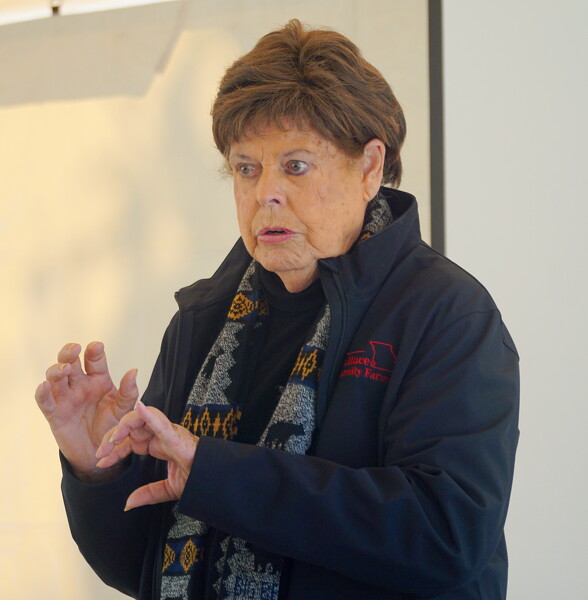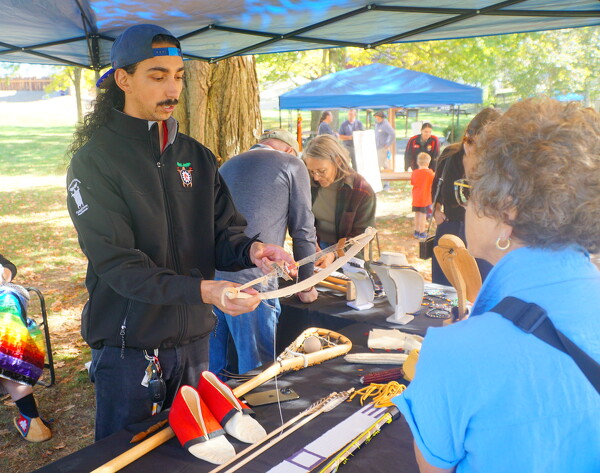
Chris Thompson, a Fort Recovery native and archaeologist at Ball State University greets attendees before leading them on a battlefield tour on Sunday afternoon, the second day of the Fort Recovery State Museum's "Beyond the Battlefield and St. Clair's Defeat: Connecting with Tribal Nations Today."
FORT RECOVERY - A Native American tribe whose population plummeted to 70 after being forced by the U.S. government to walk 700 miles from the Ohio River Valley to present-day Oklahoma in 1832 has since rebounded to more than 3,900 members located in all 50 states.
The Eastern Shawnee Tribe of Oklahoma, descendants of the Shawnee who joined a confederation that defeated U.S. Gen. Arthur Sinclair near what is now Fort Recovery, owns a casino, banks and other businesses, according to Chief Glenna Wallace.
Wallace was one of the keynote speakers headlining the second "Beyond the Battlefield and St. Clair's Defeat: Connecting with Tribal Nations Today," at Fort Recovery State Museum over the weekend.
The free two-day event featured citizens of four federally recognized tribes whose ancestors were part of a confederacy that in 1791 achieved the greatest Native American victory over the United States.

Chief Glenna Wallace gives a detailed presentation about the Eastern Shawnee Tribe of Oklahoma to a large crowd on Sunday afternoon in Fort Recovery.
"We didn't have a single thing until 1977, not a single thing," Wallace said of the East Shawnee Tribe based in Ottawa County, Oklahoma. "Since 1977, I will tell you specifically what has changed us and that's when gaming came in … that gave us a way of making a living."
What started as a simple bingo operation with a staff of 14 has over time morphed into casinos employing about 1,000 people, according to Wallace.
"Our gaming, we've always said, if others can do it, we're just as smart, we can learn how, and so we don't have professional people who manage our gaming or our other businesses," she said.
The tribe, Wallace noted, has subsequently made good investments.
"We now own five banks. We just purchased a 1,300-acre turnkey farm, 500 head of cattle, all of the equipment," she said. "So in 47 years, I say just look at what this tribe has done, just look what this tribe has done. And there isn't any reason why we can't continue to be like this, but … we have to mind our Ps and Qs, as you say. We have to work."
When buying something, if the Eastern Shawnee don't have the ability to run it, they hire - and learn - from the best.
"We'll give you a five-year contract, and at the end of five years we want to be trained in everything you do and can do it ourselves," she said.
But the tribe, which gained federal recognition in 1936, to this day also contends with a troubled legacy stemming from the U.S. government pushing them into exile under the Indian Removal Act of 1830.
President Andrew Jackson was primarily responsible for the act, she said, adding that many Native Americans still refuse to cary $20 bills which carry Jackson's portrait.
"We were living on a reservation with another tribe that was removed at the same time we were, and we were called the Mixed Band of Seneca and Shawnees. We were living in a reservation, Lewistown, which is located near Wapakoneta," she said.
In 1832, tribe members walked the entire way, about 700 miles, to Indian Territory in present-day Oklahoma, a grueling four-month trek.
"Our tribe was the first. We walked from September to December," she said. "It was actually stated that when the United States was figuring the cost of removing the tribe … no person was worth more than $20 a head. They ran out of money within 100 miles."
The Native Americans had to subsist on squash and pumpkins.
"We've had more people die and more people die. The very first thing that we established there was a cemetery. So we have a cemetery that's dated 1832," Wallace said.
According to an 1831 treaty, the Seneca and Shawnees together were to receive 60,000 acres. Yet the Shawnee ended up with a mere 58.1 acres, she said.
Fast-forwarding three decades later, Wallace said her people had fought on the side of the Confederacy during the Civil War, and their chief was later charged with treason and imprisoned.
Consequently, they were forced to sell much of their land to five other tribes, according to Wallace.
Then the U.S. government in the late 1800s passed an allotment act.
"Which means the land is not in the ownership of the tribe. It now goes to individuals, and so what was not given in allotment, the United States kept and sold off," she said. "So we ended up with 58.19 acres, and that 58.19 acres is a floodplain."
As such, the area gets flooded every year.
"We have had to buy additional land, and we are in the process and have been for these 15 years of moving what we have on that 58.19 acres up about 4 or 5 miles beyond and creating a new place for ourselves," Wallace said.
As well as facing constant flooding, the Eastern Shawnee have been exposed to a noxious environment. Ottawa County, Wallace said, was at one point home to many lead and zinc mines.
"You know how poisonous and how much pollution lead and zinc mines cause. There were no laws that forced the mines when they went out of existence to repay or to clear up or remove the pollution," she said. "So for the last 30 years, Ottawa County has either been first or second of the most polluted counties in the United States."
Wallace said her alcoholic father believed the only way he could resist alcohol was by escaping the mines. Her extended family of 11 took off in her father's old flatbed farm truck to the West Coast where they barely got by laboring as migrant workers for three years.
"Many, many things about being a Native American I am so proud of, but there are things that I am not proud of. Our statistics are horrible," Wallace said. "We have the highest alcoholism rate of any minority. We have the highest suicide rate of any minority. We have the highest dropout rate from public schools of any minority. We have the lowest entry rate into college of any minority."
But Wallace herself did something remarkable to avoid becoming another number of a government chart. Taking the work ethic and goal-setting skills she learned while toiling in the fields as a migrant girl - a period during which she and her family found themselves sleeping in pigsties and on hay bales in barns - Wallace committed herself to getting an education.
She finished high school and went on to earn numerous college degrees before launching her career at Crowder College in Neosho, Missouri. For more than 38 years, she worked at the college as an instructor, department chair, division chair, director of travel and interim academic dean.
Moreover, she visited 70 countries and in 2006 became the first woman elected chief of the Eastern Shawnee.
"I say I am proud of that, but I am even more proud of the fact that I have been reelected four times, so that I had to prove that women could do something or the men would not have reelected me," Wallace said.
More recently, Wallace helped successfully advocate for a network of ancient American Indian ceremonial and burial mounds in Ohio being named to the list of UNESCO World Heritage sites in September 2023.
Preservationists, led by the Ohio History Connection, and indigenous tribes, many with ancestral ties to the state, pushed to recognize the Hopewell Ceremonial Earthworks for their good condition, distinct style and cultural significance - describing them as "masterpieces of human genius."
UNESCO's World Heritage Committee approved the application during a meeting in Saudi Arabia. It took the 21 countries only 3 minutes to give their blessing, making the earthworks the first World Heritage site in Ohio and the 25th in the United States, Wallace said.
"They were most impressed with our nomination of anyone there," she said. "I was able to speak on behalf of the United States. Even more important than the United States, I was able to speak on behalf of my ancestors."
The massive earthworks comprise eight ancient sites spread across 90 milesof what is present-day southern Ohio, including one located on the grounds of a private golf course and country club. The designation puts the spot in the same category as wonders of the world including Greece's Acropolis, Peru's Machu Picchu and the Great Wall of China.
Ohio History Connection announced a deal on Aug. 1 that will allow it to take control on Jan. 1 of the earthworks site located on the site of a golf course, ending years of litigation.
It will pay Moundbuilders Country Club in Newark to buy out its lease and end the long-running legal dispute over the Octagon Earthworks, although the sum is confidential under a settlement agreement. The deal avoids a jury trial to determine the site's fair market value that had been repeatedly postponed over the years.
- The Associated Press contributed to this article.

Joshua Garcia, a media/communication specialist with the Wyandotte Nation of Ottawa county, Oklahoma, talks about tools, implements and instruments of the Wyandotte tribe.

